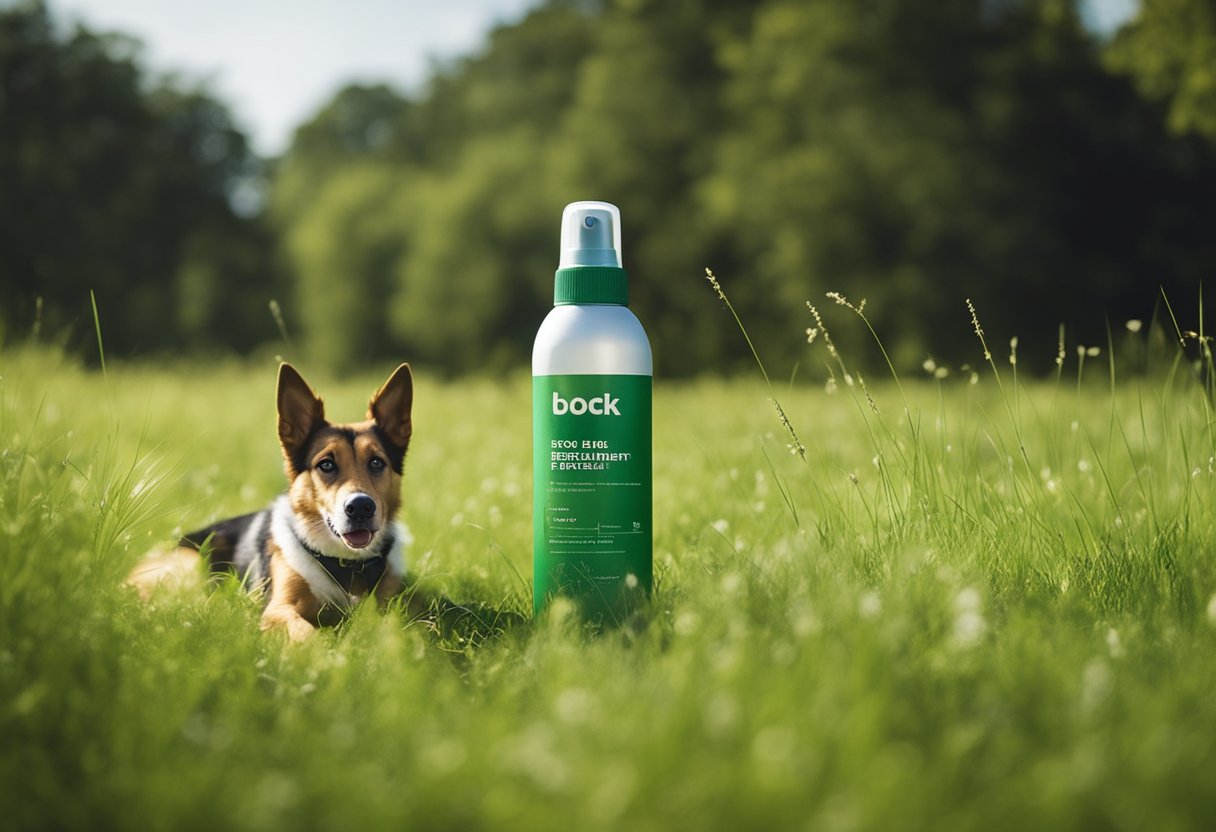
What Kills Ticks on Dogs Instantly?
Contents
- 1 Best Tick Prevention Products
- 2 Introduction
- 3 Immediate Tick Removal Techniques
- 4 Preventative Care and Maintenance
- 5 Understanding Tick Dangers and Diseases
- 6 Professional Treatments and Services
- 7 Frequently Asked Questions
- 7.1 What home remedies can I use to quickly eliminate ticks on my dog?
- 7.2 Is it safe to use hand sanitizer to kill ticks on my dog?
- 7.3 How effective is using vinegar to kill ticks on canines?
- 7.4 Can common disinfectants like Dettol be used to combat ticks on pets?
- 7.5 What methods exist for removing ticks from a dog without causing them to burrow deeper?
- 7.6 Are there natural solutions, such as salt, for managing tick infestations on dogs?
Best Tick Prevention Products
 | Beloved Pets Flea and Tick Prevention Treats | Natural chewable tablets are given daily. Dosage depended on the weight of the dog. |
 | K9 Advantix II Flea, Tick & Mosquito Treatment & Prevention. | Drops are applied to the dog’s skin. One application lasts 30 days. |
 | Seresto Flea & Tick Treatment & Prevention Collar for Dogs | A medicated collar that can offer up to 8 months of protection. |
Introduction
Ticks on dogs are not just a nuisance but also a health hazard, as these parasites can carry diseases that may be transmitted to your pet and sometimes to humans. Luckily, there are fast-acting methods to eliminate ticks from your dog. These methods include using fine-tipped tweezers or tick removal tools to carefully extract the tick from the skin, applying isopropyl alcohol to kill the tick, or employing commercially available products designed to kill ticks on contact. It is crucial to approach tick removal with care to prevent leaving any part of the tick embedded in your dog’s skin, which can cause infection.

We understand the urgency to find solutions that will quickly and safely remove ticks from your beloved pet. Alongside immediate removal techniques, it’s also vital to consider ongoing preventative care. This can be achieved through the use of oral or topical medications, tick collars, or even certain natural remedies that may deter ticks from attaching in the first place. Recognizing the dangers that ticks pose is the first step in ensuring the health and comfort of your canine friend. A thorough approach to tick control includes both reactive measures and preventive strategies.
Key Takeaways
- Effective tick removal and killing methods include using tweezers, alcohol, and commercial products.
- Ongoing tick prevention is important for your dog’s long-term health and comfort.
- Understanding tick dangers helps inform the best care and prevention strategies.
Immediate Tick Removal Techniques

When we discover ticks on our dogs, it’s crucial to remove them swiftly to minimize the risk of disease transmission. Let’s explore both physical and chemical methods for immediate tick elimination.
Physical Removal Methods
Safe Tick Removal Steps:
- Use Fine-tipped Tweezers: Grip the tick as close to the skin’s surface as possible.
- Pull Upward Steadily: Avoid twisting or jerking the tick, as this can cause the mouth-parts to break off and remain in the skin.
- Clean the Bite Area: After removal, cleanse the area with rubbing alcohol or soap and water.
Chemical Solutions
Direct Tick Treatments:
- Isopropyl Alcohol: Applying isopropyl alcohol can kill ticks immediately. Ensure to handle it with care and avoid the dog’s eyes and mouth.
- Eucalyptus Oil Dilution: A mixture of eucalyptus oil in water can act as a natural tick repellent. Use it with caution, as essential oils can be potent.
Recommended Precautions:
- Always wear gloves.
- Dispose of ticks securely; submerse in alcohol, place in a sealed bag, or flush down the toilet.
- Never crush a tick with your fingers.
Note: While these methods can kill ticks, prevention with regular tick treatments is essential for our dog’s health.
Preventative Care and Maintenance

To keep our dogs tick-free, we focus on containment, regular grooming and use of the right tick-preventative products. Let’s dive into how these steps can provide the best treatment options for our furry friends.
Regular Grooming
We know that keeping our dogs well-groomed is essential. By regularly brushing their fur, we help in the early detection of ticks before they settle in. We recommend using a fine-toothed comb, as it can catch ticks that might be hiding in the dog’s coat.
Tick Preventative Products
When it comes to products, we have several options that effectively prevent tick infestations:
- Oral Medications: Beloved Pets Flea and Tick Prevention Treats. These are chewable tablets given daily.
- Topicals: K9 Advantix II Flea, Tick & Mosquito Treatment & Prevention. Drops are applied to the dog’s skin. One application lasts 30 days.
- Collars: Seresto Flea & Tick Treatment & Prevention Collar for Dogs. Medicated collars like Seresto can offer up to 8 months of protection.
Remember, it’s important for us to choose the product that fits our lifestyle and our dog’s needs. Always consult our vet before starting any new treatment.
Understanding Tick Dangers and Diseases

Ticks are notorious pests that pose a risk to our beloved dogs. These tiny creatures attach to the skin and feast on blood. During this process, they can transmit a variety of diseases that are harmful to both dogs and humans.
Common tick-borne diseases:
- Lyme Disease: Caused by the bacterium Borrelia burgdorferi and transmitted by black-legged ticks, also known as deer ticks.
- Ehrlichiosis: Transmitted mainly by the lone star tick, it can cause fever, muscle aches, and other symptoms.
- Rocky Mountain Spotted Fever (RMSF): Transmitted by the American dog tick, symptoms include fever and a distinctive rash.
- Tularemia: A less common but serious illness that can be transmitted by ticks.
Preventative measures:
- Regular checks: Inspect our dogs daily for ticks, especially after walks or playtime in grassy or wooded areas.
- Tick treatments: There are various treatments available to protect our dogs. Topical treatments, oral medications, and tick collars are commonly used.
Immediate action:
- If a tick is found, it’s important to remove it immediately. Use tweezers to grasp the tick as close to the skin as possible and pull steadily without twisting. It’s crucial to ensure all parts of the tick are removed to prevent infection.
By understanding the dangers ticks pose and the diseases they carry, we’re better equipped to protect our dogs. Effective treatments are our best defence against these parasites and the illnesses they may carry.
Professional Treatments and Services

When we’re looking to protect our furry friends from ticks, professional treatments are reliable options. Let’s explore what veterinary solutions are available.
Veterinary Solutions
Our best line of defence against ticks often consists of veterinarian-recommended treatments. These methods are specifically designed to be powerful and fast-acting. We can consider the following:
- Oral Medications: Pills or chews prescribed by a vet that can kill ticks quickly. These are usually given once a month and are effective in not just killing ticks but also preventing future infestations.
- Topical Treatments: Applied directly to the skin of our dog, these treatments spread over the body to provide full coverage. They typically start killing ticks within a few hours after application.
- Tick Collars: Medicated collars can provide long-term protection against ticks, often up to several months. They work by releasing tick-repellent chemicals around our dog’s neck and body.
It’s important for us to consult with our veterinarian, as they can recommend the best treatment tailored to our dog’s needs and the tick risks in our area. By utilizing these professional treatments and services, we ensure that our dogs get the swift and effective protection they need against ticks.
Frequently Asked Questions

In this section, we’ll cover some common queries on how to quickly eliminate ticks from your dog, using various substances that are often readily available at home.
What home remedies can I use to quickly eliminate ticks on my dog?
For a quick home remedy, you can apply alcohol or a mixture of dish soap and water to the tick. These methods are meant to suffocate and kill the tick for easier removal.
Is it safe to use hand sanitizer to kill ticks on my dog?
Using hand sanitizer, which contains alcohol, can be an effective method to terminate ticks on contact. However, use this with caution and avoid the dog’s eyes and any open wounds.
How effective is using vinegar to kill ticks on canines?
Vinegar, particularly apple cider vinegar, is touted by some as a natural remedy against ticks. Its effectiveness varies and it might not kill ticks instantly, but it can potentially help in repelling them.
Can common disinfectants like Dettol be used to combat ticks on pets?
While disinfectants like Dettol are antimicrobial, it is not recommended to use harsh chemicals on your dog’s skin. It can irritate and may not be safe for your pet.
What methods exist for removing ticks from a dog without causing them to burrow deeper?
To remove a tick without causing it to burrow deeper, use fine-tipped tweezers to grasp the tick as close to the skin’s surface as possible, pulling upward with steady, even pressure. This method minimizes the chances of the tick’s mouth-parts breaking off and remaining in the skin.
Are there natural solutions, such as salt, for managing tick infestations on dogs?
While salt is often suggested for killing ticks due to its desiccating properties, it is not an instant remedy and its effectiveness is not scientifically proven. Always consult with a vet before trying new remedies.




